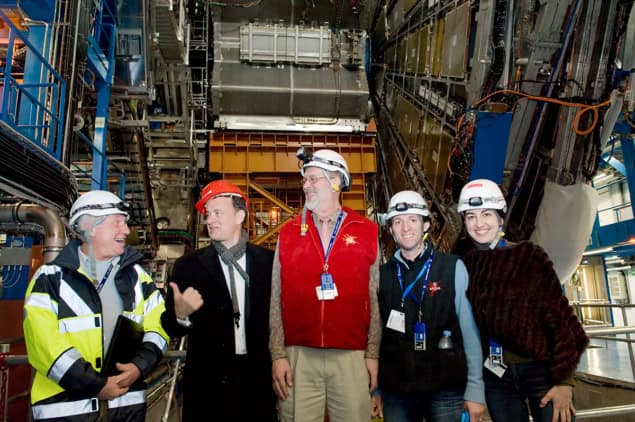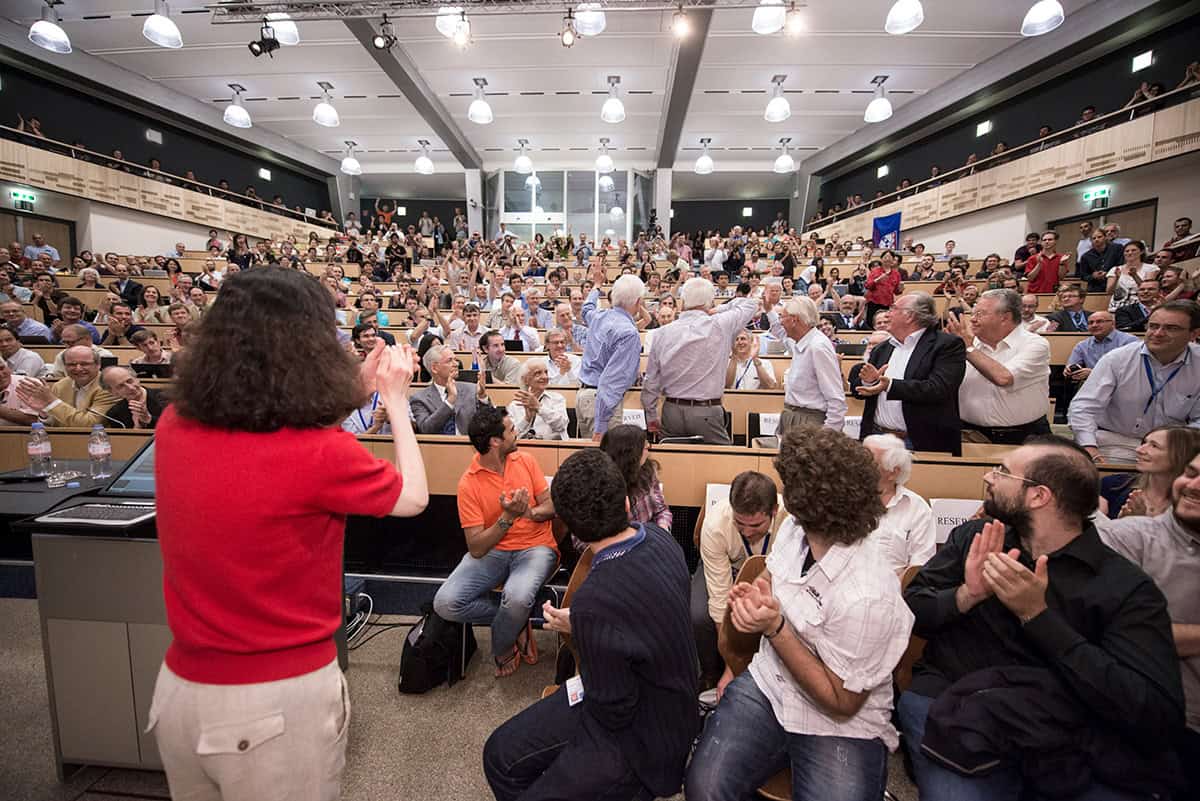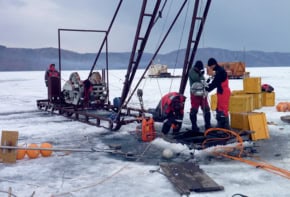With CERN turning 70 this year, the lab’s former head of communications James Gillies reveals how his team handled unprecedented global interest in the world’s most powerful collider, which ranged from fears of killer black holes to visits from celebrities

“Read this,” said my boss as he dropped a book on my desk sometime in the middle of the year 2000. As a dutiful staff writer at CERN, I ploughed my way through the chunky novel, which was about someone stealing a quarter of a gram of antimatter from CERN to blow up the Vatican. It seemed a preposterous story but my gut told me it might put the lab in a bad light. So when the book’s sales failed to take off, all of us in CERN’s communications group breathed a sigh of relief.
Little did I know that Dan Brown’s Angels & Demons would set the tone for much of my subsequent career. Soon after I finished the book, my boss left CERN and I became head of communications. I was now in charge of managing public relations for the Geneva-based lab and ensuring that CERN’s activities and functions were understood across the world.
I was to remain in the role for 13 eventful years that saw Angels & Demons return with a vengeance; killer black holes maraud the tabloids; apparently superluminal neutrinos have the brakes applied; and the start-up, breakdown and restart of the Large Hadron Collider (LHC). Oh, and the small business of a major discovery and the award of the Nobel Prize for Physics to François Englert and Peter Higgs in 2013.
Fear, black holes and social media
Back in 2000 the Large Electron-Positron collider, which had been CERN’s flagship facility since 1989, was reaching the end of its life. Fermilab was gearing up to give its mighty Tevatron one more crack at discovering the Higgs boson, and social media was just over the horizon. Communications teams everywhere struggled to work out how to adapt to this new-fangled phenomenon, which was giving a new platform to an old emotion.
Fear of the new is as old as humanity, so it’s not surprising that some people were nervous about big machines like the Tevatron, the Relativistic Heavy Ion Collider and the LHC. One individual had long been claiming that such devices would create “strangelets”, mini-black holes and other supposedly dangerous phenomena that, they said, would engulf the world. Before the Web, and certainly before social media, theirs was a voice in the wilderness. But social media gave them a platform and the tabloid media could not resist.

For the CERN comms team, it became almost a full-time job pointing out that the LHC was a minnow compared to the energies generated by the cosmos. All we were doing was bringing natural phenomena into the laboratory where they could be easily studied, as I wrote in Physics World at the time. Perhaps the Nobel-prize-winning physicist Sam Ting was right to switch his efforts from the terrestrial cacophony to the quiet of space, where his Alpha Magnetic Spectrometer on the International Space Station observes the colossal energies of the universe at first hand.
Despite our best efforts, the black-hole myth steadily grew. At CERN open days, we arranged public discussions on the subject for those who did not know quite what to make of it. Most people seemed to realize that it was no more than a myth. The British tabloid newspaper the Sun, for example, playfully reminded readers to cancel their subscriptions before LHC switch-on day.
There were lawsuits, death threats and calls for CERN to be shut down
But some still took it seriously. There were lawsuits, death threats and calls for CERN to be shut down. There were reports of schools being closed on start-up day so that children could be with their parents if the world really did end. Worse still, in 2005 the BBC made a drama documentary End Day, seemingly inspired by Martin Rees’s book Our Final Century. The film played out a number of calamitous scenarios for humankind, culminating with humanity taking on Pascal’s wager and losing. I have read the book. That is not what Rees was saying.
We were now faced with another worry. Brown’s follow-up book, The Da Vinci Code, had become a blockbuster and it was clear that Angels & Demons, after its slow start, would follow suit. I therefore found myself in a somewhat surreal meeting with CERN’s then director-general (DG) Robert Aymar mulling over how CERN should respond. I suggested that the book’s success was a great opportunity for us to talk about the real physics of antimatter, which is anyway far more interesting than the novel.
To my relief, Aymar agreed – and in 2005 visitors to CERN’s website were greeted with a picture of our top-secret space plane that the DG uses to hop around the world in minutes. Or does he? Anyone clicking on the picture would discover that CERN doesn’t actually have a space plane, but we do make antimatter. We could even make a quarter of a gram of it, given 250 million years.

CERN at 70: how the Higgs hunt elevated particle physics to Hollywood status
More importantly, we hoped that visitors to the website would learn that the really interesting thing about antimatter is that nature seems to favour matter and we still don’t know why. They’d also discover that antimatter plays an important role in medicine, in the form of positron-emission tomography (PET) scanners, and that CERN has long played an important part in their development.
Thanks to our playful, interactive approach, many people did click through. In fact, CERN’s Web traffic jumped by a factor of 10 almost overnight. The lab was on its way to becoming a household name and, in time, a synonym for excellence. In 2005, however, that was yet to come. We still had several years of black-hole myth-busting ahead.
Collider countdown
A couple of years later, an unexpected ally appeared in the form of Hollywood, which came knocking to ask if we’d be comfortable working with them on a film version of Angels & Demons. Again, the DG agreed and in 2009 the film appeared, starring Tom Hanks, along with Ayelet Zurer as a brilliant female physicist who saves the day. Fortunately, much of the book’s dodgy science and misrepresentation of CERN didn’t make it onto the screen (see box below).
Of course, the angels, the demons and the black holes were all a distraction from CERN’s main thrust – launching the LHC. By 2008 Fermilab’s Tevatron was well into its second run, but the elusive Higgs boson remained undiscovered. The mass range available for it was increasingly constrained and particle physicists knew that if the Tevatron didn’t find it, the LHC would (assuming the Higgs existed). The stakes were high, and a date was set to thread the first beams around the LHC. First Beam Day would be 10 September 2008.
Angels & Demons: when Hollywood came to CERN

Dan Brown’s 2000 mystery thriller Angels & Demons is a race against the clock to stop antimatter stolen from CERN from blowing up the Vatican. Despite initial slow sales, the book eventually proved so successful that it was turned into a 2009 movie of the same name, directed by Ron Howard. He visited CERN more than once and I was impressed by his wish to avoid the book’s shaky science.
In the movie version, which stars Tom Hanks and Ayelet Zurer, CERN is confined to the pre-opening title sequence, with the ATLAS cavern reconstructed in CGI. Howard’s team even gave me a watermarked script and asked for feedback on the science. Howard also made a short film about CERN for the movie’s Blu-ray release. Ahead of that event, we found ourselves fielding calls from Howard’s office at all times of day and night about the science.
The movie was officially launched at CERN to the entertainment press, with Howard, Hanks and Zurer in attendance, who all gushed what an amazing place the lab is. Handled by Sony Pictures, the event proved much more tightly controlled than typical CERN gatherings, with Sony closely vetting which science journalists we’d invited. My colleague Rolf Landua and I ended up having dinner with Hanks, Zurer and Howard – something I could never have imagined happening when Angels & Demons first came out.
Any big new particle accelerator is its own prototype. Switching such a machine on is best done in peace and quiet, away from the media glare. But CERN’s new standing on the world’s stage, coupled with the still-present black-hole myth, dictated otherwise. Media outlets started contacting us – not to ask if they could come for the switch-on, but to tell us they would be there. Outside the CERN fence if necessary.
Another surreal conversation with the DG ensued. Media were coming, I told him, whether we liked it or not. Lots of them. We could either make plans to invite them in and allow them to follow the attempts to get beams around the LHC, or we could have them outside the lab reporting that CERN was starting the doomsday machine in secrecy behind the fence.
Around 1000 media professionals representing some 350 outlets descended on the lab
The DG agreed that it might be better to let them in, and so we did. Around 1000 media professionals representing some 350 outlets descended on the lab. Among them was a team from BBC Radio 4. Some months earlier, a producer called Sasha Feachem had rung CERN to say she’d been trying to persuade her boss, Mark Damazer, to do a full day’s outside broadcast from CERN, and would I come to London to convince him.
I tried, and in an oak-panelled room at Broadcasting House, failed completely to do so. But Damazer did accept an invitation to visit CERN. After hitting it off with the DG, Radio 4’s Big Bang Day was approved and an up-and-coming science presenter by the name of Brian Cox was chosen to anchor the BBC’s coverage. It was the first time a media team had ever broadcast wall-to-wall from a science lab and I don’t think Radio 4 has done anything like it since.
Journalists were accredited. A media centre was set up. Late-coming reporters were found places in the CERN main auditorium where they could watch a live feed from the control room, along with the physicists. We even installed openable windows in the conference room overlooking the control room so that TV crews could get clean shots of the action below.

A time was set early that September morning for the first attempt at beam injection into the LHC, and the journalists were all in place. Then there was a glitch, and the timing was put back a couple of hours. Project leader Lyn Evans had agreed to give a countdown, and when the conditions for injection were back, he began. A dot appeared on a screen indicating that a proton beam had been injected.
After an agonising wait, a second dot appeared, indicating that the beam had gone round the 27 km-long machine once. There were tears and laughter, and the journalists who were parked in the auditorium with the physicists later said they’d had the best seats in the house. They were able to witness the magnitude of that moment alongside those whose lives it was about to change.
It was an exhausting but brilliant day. On my way home, I ran into Evans as he was driving out of the lab. He rolled down his window and said: “Just another day at the office, eh James!” Everyone was on top of the world. Media coverage was massive and positive, with many of those present telling us how refreshing it was to take part in something so clearly genuine in a world where much is hidden.
From joy to disaster
The joy proved short lived. The LHC has something like 10,000 high-current superconducting interconnects. One was not perfect, so it had a bit of resistance, which led to an electrical arc that released helium into the cryostat with enough force to knock several magnets off their stands. Nine days after switch-on, CERN suddenly had a huge and unexpected repair job on its hands.
The Higgs boson was still nowhere in sight. The Tevatron was still running and the painstaking task began of working out what had gone wrong at the LHC. CERN not only had to repair the damaged section, but also understand why it had happened and ensure it wouldn’t happen again. Other potentially imperfect interconnects had to be identified and remade. The machine also had to be equipped with systems that would release pressure should helium gas build up inside the cryostat.

My mantra throughout this period was that CERN had to be honest, open, trustworthy and timely in all communications – an approach that, I think, paid dividends. The media were kind to us, capturing the pioneering nature of our research and admiring the culture of an organization that sought not to attribute blame, but to learn and move on.
When beams were back in the LHC in November 2009, they cheered us on. By the end of the year, the first data had been recorded. LHC running began in earnest in 2010, and with the world clearly still in place, the black-hole myth gave way to excitement about a potential major discovery. The Tevatron collided its last beams in September 2010, leaving the field clear for the LHC.
As time progressed, hints of something began to appear in the data, and by 2012 there was a palpable sense of expectation
As time progressed, hints of something began to appear in the data, and by 2012 there was a palpable sense of expectation. A Higgs Update Seminar was arranged at CERN for 4 July – the last day possible for the spokespeople of the LHC’s ATLAS and CMS experiments to be at CERN before heading to Melbourne for the 2012 International Conference on High-Energy Physics, which is always a highlight in particle physicists’ calendars.
Gerry Guralnik and Carl Hagan – early pioneers of spontaneous symmetry breaking – asked whether they could attend the CERN seminar, so we thought we’d better invite Peter Higgs and François Englert too. (Robert Brout, who had been co-author on Englert’s 1964 paper in Physical Review Letters (13 321) predicting what we now called the Brout–Englert–Higgs mechanism, had died in 2011.) Right up to the last minute, we didn’t know if we’d be making a discovery announcement, or just saying “Watch this space.” One person, however, did decide that he’d be able to say, “I think we have it.”
As DG since 2009, Rolf-Dieter Heuer had seen the results of both experiments, and was convinced that even if neither could announce the discovery individually, the combined data were sufficient. On the evening of 3 July 2012, as I left my office, which was next to the CERN main auditorium, I had to step over people laying out sleeping bags in the corridor to guarantee their places in the room the next day.

As it turned out, both experiments had strong enough measurements to make a positive statement on the day, though the language was still cautious. The physicists talked simply about “the discovery of a new particle with features consistent with those of the Higgs boson predicted by the Standard Model of particle physics”. Higgs and Englert heard the news seated side by side, Higgs famously wiping a tear from his eye and saying that it was remarkable that the discovery had been made in his lifetime.
The media were present in force, and everyone wanted to talk to the theorists. It’s a sign of the kind of person Higgs was that he told them they’d have plenty of opportunity to talk to him later, but that today was a day to celebrate the experimentalists.
Nature versus nature
The Higgs discovery was undoubtedly the highlight of my career in communications at CERN, but the Higgs boson is just one aspect of CERN’s research programme. I could tell you about the incredible precision achieved by the LHCb experiment, seeking deviations from the Standard Model in very rare decays. I could talk about the discovery of a range of composite particles predicted by theory. Or about the insights brought by a mind-boggling range of research at low energies, from antimatter to climate change.

Discovering the Higgs boson: a day in physics like no other
Then there is CERN’s neutrino programme. It’s now focused on the US long baseline project, but it brought its own headaches to the communications team when muon neutrinos from CERN’s Super Proton Synchrotron appeared to be arriving at the Gran Sasso Laboratory in Italy faster than the speed of light.
“Have you checked all the cables?” said one of our directors to the scientists involved, in a meeting in the DG’s office. “Of course,” they insisted. As it turned out, there had been a false reading – not strictly speaking from a poorly chosen cable, but a faulty fibre-optic connection. The laws of physics were safe. Unfortunately, this was not before a seminar was held in the CERN Main Auditorium in September 2011.
Had they held the seminar at Gran Sasso, I’m sure they’d have got less coverage. Our approach was to say: “This is how science works – you get a measurement that you don’t understand, and you put yourself up to scrutiny from your peers.” It led to a memorable editorial in Nature (484 287) entitled “No shame“, which concluded that “Scientists are not afraid to question the big ideas. They are not afraid to open themselves to public scrutiny. And they should not be afraid to be wrong.”
Nature caught us off guard, not once but twice, when animals brought low the world’s mightiest machine
That remark in Nature was a positive outcome for CERN from a potentially embarrassing episode, but nature of another kind caught us off guard, not once but twice, when animals brought low the world’s mightiest machine. First, breadcrumbs and feathers led us to believe that a bird had had a lucky escape when it tripped an electrical substation. Later, a pine marten, which also caused a power outage after gnawing through a live cable, was not so lucky. It has now joined the gallery of animals that have met unusual ends in the Rotterdam Museum of Natural History.

There were also visitors. Endless visitors, from school children to politicians and from pop stars to artists. On a return visit of my own to Antony Gormley’s London studio after having given him a tour of CERN, he spontaneously presented me with one of his pieces. Feeling Material XXXIV – a metal sculpture that’s part of a series giving an impression of the artist’s body – now hangs proudly in CERN’s main building
There was an incredible moment at one of the TEDxCERN events we organized when Will.i.am joined two local children’s choirs for a rendition of his song “Reach for the Stars”. And there were many visits from the late landscape architect Charles Jencks and Lily Jencks who produced a marvellously intelligent design for a new visitor centre in the form of a cosmic Ouroboros – like a snake biting its own tail, it appeared like two mirror-image question marks forming a circle. One of my only regrets is that we were unable to fund its construction.
For a physicist-turned-science-communicator such as myself, there was no better place to be than at my desk through the opening years of the 21st century. CERN is a unique and remarkable institution that shows what humanity is capable of when differences are cast aside, and we focus on what we have in common. To paraphrase Charles Jencks, to whom I’m leaving the last word, CERN is perhaps the last bastion of the enlightenment.



